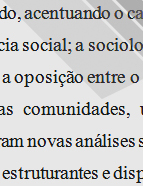

................................
The genesis of this theoretical “revolution” was intertwined with a plural epistemological network that emerged in the early decades of the 20th century and changed the way power and society were viewed. Among many others, the following are particularly noteworthy the microsociology of Georg Simmel (1858-1918), which contributed to the de tion of the mechanisms of political centrality; the taxonomic languages of political and social differentiation based on the works of Norbert Elias (1887-1990) on court society and the civilising process; the discovery of the autonomy of certain instruments and practices of the State (bureaucracy and administration) following Max Weber’s (1864-1920) contribution to the understanding of institutions as durable social forms of power organisation ; Émile Durkheim’s (1858-1917) sociological critique of liberal legal theory, particularly the monopoly of the imposition of the supra-individual power of the State, emphasising the social and solidarity-based nature of legal and institutional norms – a kind of social conscience; the sociology of Georges Gurvitch (1894-1945), highlighting the “unofficial” aspects of law, the opposition between written law and living law rooted in traditions, customs and community life, a web of multifaceted and plural powers; the various structuralisms that opened up new analyses of power (symbolic production, processes of inculcation, imposition of structuring structures and disciplinary devices) that would be incorporated into the theoretical arsenal of postmodernity (e.g. Pierre Bourdieu, Michel Foucault, Gilles Deleuze, Pierre Legendre and Félix Guattari - for a framework for these issues and bibliography, see Hespanha , 1986). More recently, it is worth highlighting the variants of neo-institutionalism with new theoretical contributions in the historical, sociological and political science fields (Hall, “The three versions of neo-institutionalism”, 2003).
This work is financed by national funds through FCT - Foundation for Science and Technology, I.P, in the scope of the projects UIDB/04311/2020 and UIDP/04311/2020.
